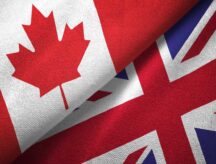Canada releases 2022 Annual Report on Express Entry

Immigration, Refugees and Citizenship Canada (IRCC) releases an annual report on Express Entry every year, the 2022 version being the latest.
Express Entry is the name of the application management system used by the federal government in Canada to attract foreign skilled workers to this country who are seeking permanent residence (PR).
Get a Free Express Entry Assessment
Launched in 2015, the Express Entry system contains three different core programs: the Canadian Experience Class (CEC), the Federal Skilled Worker Program (FSWP) and the Federal Skilled Trades Program (FSTP).
It is also worth noting that this system does manage a portion of the Provincial Nominee Program (PNP), although PNP candidates must also be eligible for at least one of the three programs noted above to come to Canada via Express Entry.
Note: All data in this article is from January to December 2022.
Number of Express Entry profiles submitted in 2022 down slightly from 2021
In 2022, 428,391 Express Entry profiles were submitted across all programs. This represents a slight decrease of 3% from 2021 but an increase of 19% from 2020. Of the profiles submitted, at least 74% were eligible for at least one of the immigration programs managed by Express Entry, which was unchanged from 2021.
More profiles were submitted by men (238,382) than women (189,881). The proportion of total profile submissions by men (56%) and women (44%) were unchanged from 2021. While the proportion of profile submissions that were eligible for at least one program has not changed from 2020 to 2022 by men (71%), there was a slight increase from previous years in 2022 by women (78%).
Most Express Entry profile submissions made by people with CRS scores between 301 and 500
The Comprehensive Ranking System (CRS) scores are used to rank Express Entry candidates based on selection criteria such as age, language ability, education, work experience and more. The report notes that the “Express Entry pool is dynamic and that the distribution of CRS scores changes” with every new eligible profile submission.
However, each year, the CRS scores for eligible candidate profiles at the time of submission remain consistently concentrated in the 301-500 range, even though the total number of eligible profiles submitted slightly decreased in 2022.
Additional CRS points can be given when a candidate has been educated in Canada, has French language proficiency or has siblings in Canada. Among individuals who submitted profiles in 2022, a majority (55%) did not meet criteria for any additional points. However, this is a gradual reduction since 2020 (63%) and 2021 (58%), meaning an increasing number of candidates are eligible for at least one type of additional point. Candidates most often met the criteria for education in Canada (23%) and having siblings in Canada (14%).
Who was invited to apply for permanent residence through Express Entry?
ITAs issued by draw in 2022
IRCC held 24 Express Entry draws and issued 46,539 invitations to apply (ITAs) in 2022, which is a 59% decrease from the 114,431 invitations issued in 2021. This reflects IRCC’s decision to temporarily pause ITAs to the Federal High Skilled immigration programs managed under Express Entry and only continuing PNP-specific rounds from September 2021 until July 2022.
In addition, because of temporary general round invitation pauses, in 2022, the majority of ITAs were issued to candidates under two programs, 19,258 under PNPs and 18,895 under the CEC.
The remaining 8,386 ITAs were issued to candidates under the FSWP and no ITAs were issued under the FSTP in 2022.
Get a Free Express Entry Assessment
ITAs issued by gender in 2022
Men received most of the Express Entry invitations issued in 2022, at 58%, similar to the amount of eligible profile submissions made by men as a proportion of total profile submissions. When looking at program type, men were issued more invitations than women in both the CEC (42% vs. 39%, respectively) and the PNP (43% vs 39%, respectively).
This contrasts with 2021, where a larger number and proportion of invitations issued to men and women were under the CEC.
ITAs issued by age in 2022
In terms of the age of candidates invited to apply, the share of invitations issued to those aged 20-29 remained the largest group in 2022, at 50%. This age category is associated with the highest number of points under the CRS. Those aged 30-34 represented the second largest age group and saw the largest proportional increase in 2022 (29%) from 2021 (19%).
ITAs issued by education level in 2022
For the most part, the number of ITAs issued to Express Entry applicants in 2022 increased according to an individual’s highest level of education. This past year, only 1% of ITAs (540) were issued to applicants with a high school diploma or less. Nine percent of all ITAs went to applicants who obtained a one or two-year post-secondary credential, and 40% of all ITAs went to those with a post-secondary credential from a program of three years or more in length. Nearly half of all 2022 ITAs (46%) went to those with a master's degree or entry-to-practice professional degree credential. Finally, PhD holders made up 4% of all ITA recipients this past year.
ITAs issued by language proficiency in 2022
Generally, more ITAs in 2022 went to those with stronger first official language proficiency, according to their Canadian Language Benchmark (CLB)/Niveaux de compétence linguistique canadien (NCLC) score.
In order of score, the following lists the number of ITAs given to applicants at each CLB/NCLC level in 2022:
- CLB/NCLC 4: 7 ITAs issued
- CLB/NCLC 5: 817 ITAs issued
- CLB/NCLC 6: 2,094 ITAs issued
- CLB/NCLC 7: 9,444 ITAs issued
- CLB/NCLC 8: 8,709 ITAs issued
- CLB/NCLC 9: 15,587 ITAs issued
- CLB/NCLC 10: 9,881 ITAs issued
ITAs issued by years of Canadian work experience in 2022
The majority of ITA recipients this past year had 1 year of Canadian work experience according to data from this report. In fact, 41% of all ITA recipients (18,986) had one year of employment experience in Canada. The next largest proportion of ITA recipients (16,066 ITAs, 35%) had no Canadian work experience. The only other group that received more than 4% of ITAs were Express Entry candidates with 2 years of Canadian employment experience, as 7,246 ITAs were given to people in this group (16%).
Candidates with the following amount of Canadian work experience received four or less percent of all Express Entry ITAs in 20222.
- Less than one year (1,957 ITAs, 4%)
- 3 years (1,528 ITAs, 3%)
- 4 years (480 ITAs, 1%)
- 5 years (276 ITAs, less than 1%)
ITAs issued by years of international/foreign work experience in 2022
Foreign work experience among 2022 ITA recipients showed an interesting trend as well, similar to Canadian work experience because ITAs did not simply rise with more years of work experience abroad. In fact, although the highest percentage of ITAs (35%) were issued to applicants with 5 or more years of foreign work experience (16,251), the next highest proportion of ITAs (12,569 ITAs, 27%) went to those with one year or less experience.
The list below outlines the remaining ITAs issued according to candidates’ foreign work experience in years:
- 1 year: 3,796 ITAs (8%)
- 2 years: 3,267 ITAs (7%)
- 3 years (6,035 (13%)
- 4 years (4,621 (10%)
ITAs issued by additional points assigned and criteria met for additional points in 2022
The report provided information on invitations issued to men and women who met the criteria to receive each additional point type. Education in Canada (19,587 ITAs) and Arranged Employment (8,756 ITAs) were the most common additional point types for which both men and women met criteria in 2022.
In 2022, Education in Canada and Arranged Employment remained as the most common additional point type for men, however the most common for women was Education in Canada and French language proficiency.
The share of additional points for Arranged Employment for both genders remained stable over the last three years, with men meeting the criteria at a higher proportion (65%) than women (35%). While the number of ITAs issued to both genders were equal in 2020 and 2021, both at 50%, women met the criteria for French-language proficiency points at a slightly higher proportion to men at 53% versus 47% in 2022.
The top three primary occupations among 2022 ITA recipients were in the technology industry
There were significant shifts from previous years in the most common primary occupations among candidates invited to apply for permanent residency through Express Entry in 2022.
In 2021, there was a shift to CEC- and PNP-specific rounds of invitations. This resulted in a significantly higher number of candidates with Training, Education, Experience and Responsibilities (TEER) 2 occupations (i.e., occupations that usually require a college diploma, including occupations that require apprenticeship training of 2 or more years, or supervisory occupations). However, candidates with TEER 1 occupations (occupations that usually require a university degree) were a significant proportion of ITAs in 2022.
Occupations related mainly to the technological field were the most common occupations for 2022. In particular, occupations such as software engineers and designers, information systems specialists and computer systems developers and programmers, were the most common occupations and made-up a significant proportion of the candidates invited to apply through Express Entry in 2022.
In addition, food service supervisors and cooks were also the top occupations for candidates invited to apply in 2022.
Software engineers and designers were assigned the most Arranged Employment points for Express Entry in 2022
The most common occupation among candidates invited to apply who were assigned Arranged Employment points changed from food service supervisors in both 2020 and 2021, to software engineers and designers in 2022.
There was an equal distribution among the TEER categories of the top 15 occupations.
Most ITA recipients were residents of Canada, India and Nigeria for the second straight year
This past year, most immigration candidates who received an ITA from the Express Entry system were residents of Canada (31,486). This continues a trend in recent years, as Canada was also the top country of residence among ITA recipients in 2021 (102,906) and 2020 (68,061). Among foreign Express Entry applicants who received an ITA, most immigrants were residents of either India (3,787) or Nigeria (1,730). These two countries also rounded out the top three a year ago.
The complete list of the top 10 countries of residence among 2022 ITA recipients is as follows (the number of ITAs issued to residents of each country is in parentheses).
1. Canada (31,486)
2. India (3,787)
3. Nigeria (1,730)
4. Cameroon (1,063)
5. United States of America (842)
6. Morocco (793)
7. United Arab Emirates (683)
8. Lebanon (559)
9. Algeria (550)
10. France (381)
Most ITA recipients held citizenship in India, followed by Algeria and China
Further data shows that the top countries of citizenship among ITA recipients have also changed slightly over time. India has taken the top spot in each of the last three years. In 2020 and 2021, the People’s Republic of China ranked second on this list. Finally, while 6,550 Nigerian citizens received ITAs in 2020 (ranked third), citizens from the Republic of Korea accounted for the third most ITA recipients (3,131) in 2021.
Similar to the above data, below is the complete list of the top 10 countries of citizenship among ITA recipients in 2022. Listed next to each country, in parentheses, is the number of ITAs their citizens were issued this past year.
1. India (20,769)
2. Algeria (2,909)
3. People’s Republic of China (2,456)
4. Cameroon (1,218)
5. Iran (1,210)
6. France (1,069)
7. Morocco (978)
8. United States of America (939)
9. Philippines (934)
10. Pakistan (923)
Most ITA recipients continue to settle in Ontario, British Columbia and Alberta
Given the long history of Canadian permanent residents largely choosing to settle in three provinces – Ontario, Quebec and British Columbia – it is worth reviewing the province of destination among the 2022 Express Entry applicants.
Continuing the trend from years prior, most Express Entry applicants (16,978) settled in Ontario in 2022. Notably, however, the percentage of applicants who settled in this province is down from 61% in 2021 to 48% this past year. British Columbia (6,966) and Alberta (4,372) were once again the next two most popular provinces of destination, accounting for 20% and 12% of all Express Entry applicants respectively.
Once again, following a similar trend as the prior two years, Canada’s three territories – Nunavut, the Northwest Territories and Yukon – were the country’s least popular Express Entry applicant destinations (78 total persons in 2022).
Note: Quebec-bound Express Entry applicants are not accounted for in this data, as the province operates its own distinct immigration programs
Express Entry application processing times generally slower than 2021
For the second consecutive year, application processing times have risen for most Express Entry applicants. In 2022, the total processing time for applications from all programs (21 months) rose from 8 months in 2021. Notably, this is largely a function of the average processing time – defined as the number of months it takes IRCC to finalize 80% of applications - for FSTP applications rising from 23 months (2021) to 63 months in 2022. Broken down by program, 80% of CEC applications were processed within 19 months (up from 6 months in 2021), while FSWP applications took 29 months (up from 28 in 2021) and PNP applications took 13 months*.
*PNP applications took 21 months to process, on average, in 2021
Conclusion
In its seventh year of operation, the Express Entry application management system continued to be a reliable source of immigration for Canada’s federal government and a popular immigration pathway to Canada for foreign nationals from around the world. Through the three programs contained within the Express Entry system, thousands more highly skilled foreign nationals were offered permanent residence in this country.
Although the number of ITAs issued in 2022 decreased by 59% from the year prior, IRCC continued to welcome qualified economic immigrants to Canada who should be able to acclimate well to this country and aid Canada’s economic and social progression.
Looking toward the future, the Express Entry system has already expanded to better target some of the areas within Canada’s labour market with the country’s most significant employment gaps and needs. This has been achieved through IRCC’s category-based Express Entry draws, first conducted on June 28, 2023. These draws specifically target immigration candidates with proficiency in French or recent work experience in the following five occupational groups: healthcare; science, technology, engineering and mathematics (STEM); transport; trades; and agriculture/agri-food. Category-based draws have been, and are expected to continue being, a key part of Canada’s progress towards addressing this country’s most potent labour market challenges.
As of the time of writing, IRCC has already issued 11,900 ITAs to immigration candidates across these targeted categories in 2023.
Canada’s immigration department will continue to look for ways that the application management system could be more effectively and profoundly used to ensure Canada can benefit from the global skilled worker community while continuing to offer these individuals one of the world’s best destinations for immigrants.
- Do you need Canadian immigration assistance? Contact the Contact Cohen Immigration Law firm by completing our form
- Send us your feedback or your non-legal assistance questions by emailing us at media@canadavisa.com





